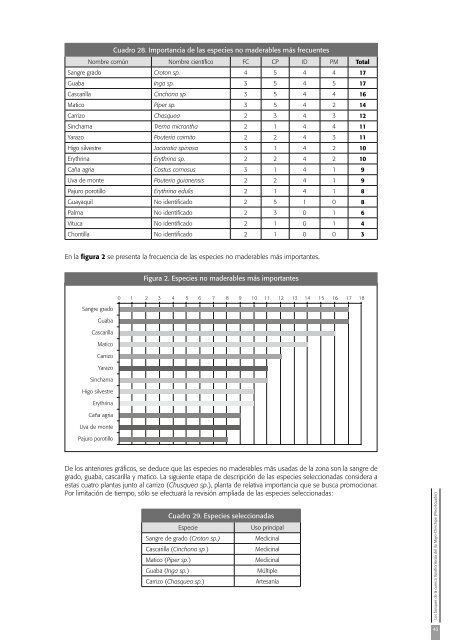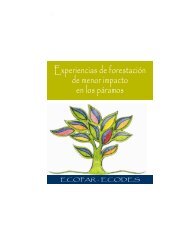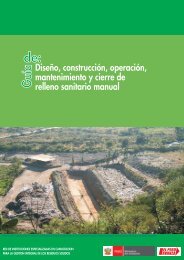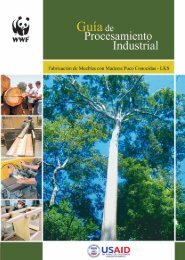Los bosques de la cuenca - RedPeIA - Ministerio del Ambiente
Los bosques de la cuenca - RedPeIA - Ministerio del Ambiente
Los bosques de la cuenca - RedPeIA - Ministerio del Ambiente
Create successful ePaper yourself
Turn your PDF publications into a flip-book with our unique Google optimized e-Paper software.
Sangre grado<br />
Guaba<br />
Cascaril<strong>la</strong><br />
Matico<br />
Carrizo<br />
Yarazo<br />
Sinchama<br />
Higo silvestre<br />
Erythrina<br />
Caña agria<br />
Uva <strong>de</strong> monte<br />
Pajuro porotillo<br />
Cuadro 28. Importancia <strong>de</strong> <strong>la</strong>s especies no ma<strong>de</strong>rables más frecuentes<br />
Nombre común Nombre científico FC CP ID PM Total<br />
Sangre grado Croton sp. 4 5 4 4 17<br />
Guaba Inga sp. 3 5 4 5 17<br />
Cascaril<strong>la</strong> Cinchona sp. 3 5 4 4 16<br />
Matico Piper sp. 3 5 4 2 14<br />
Carrizo Chasquea 2 3 4 3 12<br />
Sinchama Trema micrantha 2 1 4 4 11<br />
Yarazo Pouteria caimito 2 2 4 3 11<br />
Higo silvestre Jacaratia spinosa 3 1 4 2 10<br />
Erythrina Erythrina sp. 2 2 4 2 10<br />
Caña agria Costus comosus 3 1 4 1 9<br />
Uva <strong>de</strong> monte Pouteria guianensis 2 2 4 1 9<br />
Pajuro porotillo Erythrina edulis 2 1 4 1 8<br />
Guayaquil No i<strong>de</strong>ntificado 2 5 1 0 8<br />
Palma No i<strong>de</strong>ntificado 2 3 0 1 6<br />
Vituca No i<strong>de</strong>ntificado 2 1 0 1 4<br />
Chontil<strong>la</strong> No i<strong>de</strong>ntificado 2 1 0 0 3<br />
En <strong>la</strong> figura 2 se presenta <strong>la</strong> frecuencia <strong>de</strong> <strong>la</strong>s especies no ma<strong>de</strong>rables más importantes.<br />
Figura 2. Especies no ma<strong>de</strong>rables más importantes<br />
0 1 2 3 4 5 6 7 8 9 10 11 12 13 14 15 16 17 18<br />
De los anteriores gráficos, se <strong>de</strong>duce que <strong>la</strong>s especies no ma<strong>de</strong>rables más usadas <strong>de</strong> <strong>la</strong> zona son <strong>la</strong> sangre <strong>de</strong><br />
grado, guaba, cascaril<strong>la</strong> y matico. La siguiente etapa <strong>de</strong> <strong>de</strong>scripción <strong>de</strong> <strong>la</strong>s especies seleccionadas consi<strong>de</strong>ra a<br />
estas cuatro p<strong>la</strong>ntas junto al carrizo (Chusquea sp.), p<strong>la</strong>nta <strong>de</strong> re<strong>la</strong>tiva importancia que se busca promocionar.<br />
Por limitación <strong>de</strong> tiempo, sólo se efectuará <strong>la</strong> revisión ampliada <strong>de</strong> <strong>la</strong>s especies seleccionadas:<br />
Cuadro 29. Especies seleccionadas<br />
Especie Uso principal<br />
Sangre <strong>de</strong> grado (Croton sp.) Medicinal<br />
Cascaril<strong>la</strong> (Cinchona sp.) Medicinal<br />
Matico (Piper sp.) Medicinal<br />
Guaba (Inga sp.) Múltiple<br />
Carrizo (Chasquea sp.) Artesanía<br />
<strong>Los</strong> <strong>bosques</strong> <strong>de</strong> <strong>la</strong> <strong>cuenca</strong> transfronteriza <strong>de</strong>l río Mayo-Chinchipe (Perú-Ecuador)<br />
43








